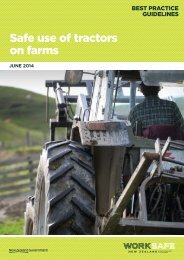PERFORMANCE
our-performance-story-2015
our-performance-story-2015
You also want an ePaper? Increase the reach of your titles
YUMPU automatically turns print PDFs into web optimized ePapers that Google loves.
24 WORKSAFE NEW ZEALAND<br />
A DIFFERENT REGULATORY APPROACH<br />
High hazard sites are often based on complex<br />
technical systems and require a different regulatory<br />
approach from those used in other sectors of the<br />
economy (eg forestry). Emerging risks are less<br />
likely to be seen easily on high hazard sites and<br />
because of this there should be close monitoring of<br />
systems and barriers to prevent catastrophes. There<br />
is also a focus on early-warning precursor events<br />
(eg small leaks from pipes or gas accumulating<br />
underground) so that unsafe events can be averted.<br />
We expect to be notified of all precursor events<br />
as per regulatory requirements, but we know that<br />
some operators are still unaware of the new need<br />
to notify and we are helping them to understand<br />
the requirements. This underscores the importance<br />
of our engagement with operators, helping them<br />
to learn about the importance of active safety<br />
management. In 2014/15 we were notified of 80<br />
potentially dangerous precursor events (56 in<br />
the petroleum industry and 24 in extractives).<br />
Our specialist inspectors determined that firms<br />
responded adequately in all but one case.<br />
GREATER OPERATOR OWNERSHIP<br />
OF SAFETY PLANS<br />
The new regulations require high hazard operators<br />
to create their own safety plans, called safety<br />
cases and principal hazard management plans.<br />
These plans help operators to demonstrate their<br />
understanding of risks and hazards within their<br />
operations and that they have adopted the right<br />
controls and mitigations. In 2014/15 we received<br />
35 plans. WorkSafe invested significant resources<br />
in assessing these documents. Each required us<br />
to follow-up with the submitters to ensure they<br />
met the required standards. This was not s<br />
urprising because the requirements were<br />
still relatively new. We expect the quality of<br />
submissions to improve in the next few years,<br />
and our guidance and proactive engagement<br />
will support this. While we will be monitoring a<br />
firm’s compliance with its own safety plan we<br />
will also be checking that sites are applying the<br />
right controls to their risks, to support safety<br />
management that is active, not just documented.<br />
BUILDING MOMENTUM WITH MAJOR<br />
HAZARD FACILITIES<br />
In the past there has been a lack of specific<br />
regulations aimed at facilities storing or processing<br />
significant quantities of substances that could<br />
cause catastrophic harm if not properly controlled<br />
(eg fuels and fertilisers). The forthcoming major<br />
hazard facilities regulations seek to protect<br />
neighbouring communities and workers from<br />
catastrophic events and place new duties on<br />
operators with facilities that have the potential<br />
for major incidents.<br />
In 2014/15 we worked with MBIE and the sector<br />
to understand the scope of the proposed major<br />
hazard facilities regulations and ensure their<br />
workability. We also identified the sites presenting<br />
greatest potential risk. It is likely that around<br />
60 facilities will meet the top thresholds for<br />
chemical storage and face higher duties under<br />
the regulations. All of these owners have now<br />
been informed of the forthcoming regulations and<br />
what they will mean in practice. We have started<br />
consulting on our draft guidance on the regulations<br />
and are developing our programme of site visits<br />
for when the regulations are in place.<br />
TARGETING HAZARDOUS<br />
SUBSTANCES<br />
It is estimated that 150,000 businesses work with<br />
hazardous substances (eg industrial chemicals<br />
and fuels) in New Zealand; these are regulated by<br />
the Hazardous Substances and New Organisms<br />
(HSNO) Act 1996. The regime focuses on human<br />
and environmental health, meaning we work closely<br />
with the Environmental Protection Authority (EPA).







